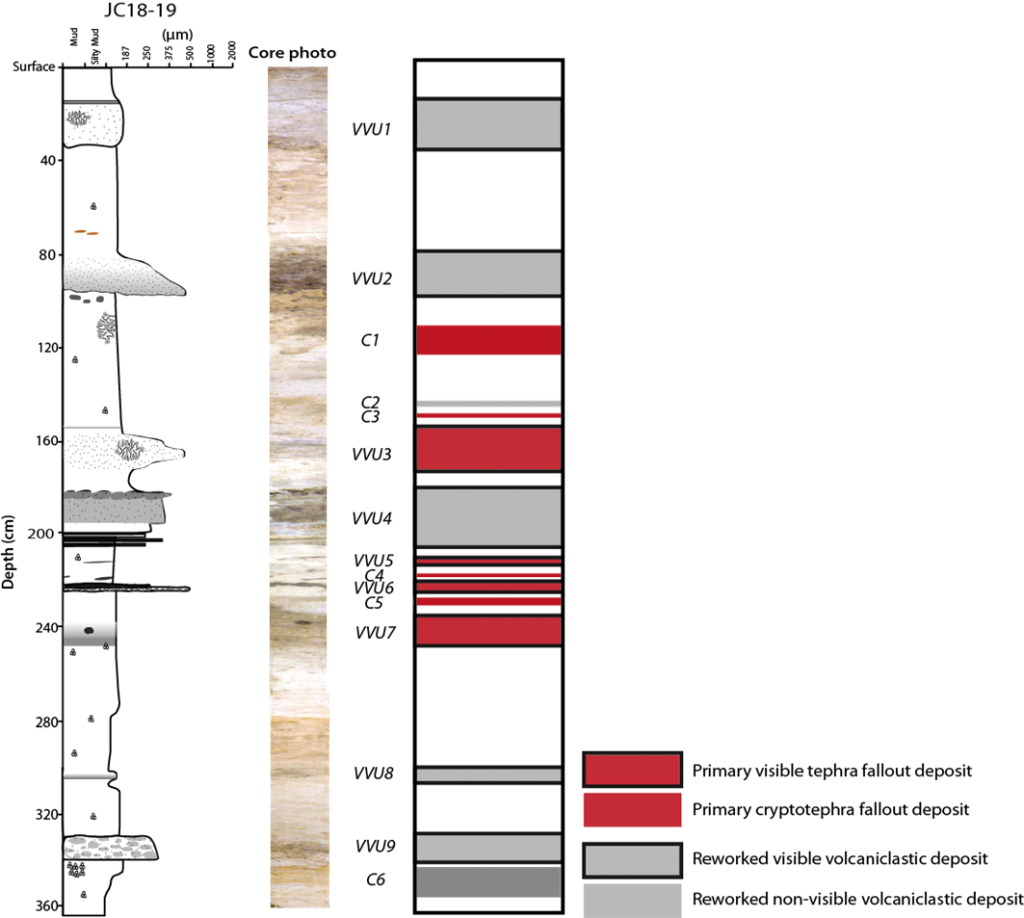 Creating records of eruptive events through time is incredibly important; these records can give us a huge wealth of information about the history of a volcano. The knowledge we can gain from eruptive records is critical to understanding what hazards a volcano may pose in the future, including: how often the volcano erupts, the style and magnitude of the eruptions and the location of potentially affected areas. These records are normally constructed by examining rock units exposed on-land, but often these deposits can be buried or eroded by subsequent volcanic flows. Also, for volcanoes that are situated near the coast (like the island of Montserrat in the Caribbean), ~75% of all the volcanic material erupted ends up in the sea. Indeed, as over two thirds of the earth is covered by water, by not looking at the oceans we are ignoring a large proportion of global volcanic deposits!
Creating records of eruptive events through time is incredibly important; these records can give us a huge wealth of information about the history of a volcano. The knowledge we can gain from eruptive records is critical to understanding what hazards a volcano may pose in the future, including: how often the volcano erupts, the style and magnitude of the eruptions and the location of potentially affected areas. These records are normally constructed by examining rock units exposed on-land, but often these deposits can be buried or eroded by subsequent volcanic flows. Also, for volcanoes that are situated near the coast (like the island of Montserrat in the Caribbean), ~75% of all the volcanic material erupted ends up in the sea. Indeed, as over two thirds of the earth is covered by water, by not looking at the oceans we are ignoring a large proportion of global volcanic deposits!
The obvious way to get around this problem is by sampling the volcanic sediments that are now preserved at the bottom of the ocean. This however, as you can imagine, is not without its difficulties. Seafloor coring/drilling requires a big ship, skilled crew and equipment to sample the bottom of the ocean (some 4 km below sea level!). However, once a core arrives on board, you are presented with a potentially comprehensive record of the volcanic events over time, and by ensuring a good coverage of cores around the volcano (or multiple volcanoes), you can gain a large amount of information about the volcanic history of the region. An added bonus with marine sediments is that between periods of volcanic activity, biogenic material falls to the bottom of the ocean and accumulates over thousands of years (hemipelagic sediment). This material can be dated, allowing the construction of the timeline of eruptions. Another important role of volcanic deposits (or tephra) in marine sediment cores is that large, widespread eruptions (such as Toba at 74 ka) can be dated directly and therefore serve as chronological markers over thousands of square kilometres. This technique, known as ‘tephrochronology’ is widely used in palaeo-climate studies to help us understand future patterns in climate change. Cores for concern? Despite all the advantages of marine sediment cores, trying to construct volcanic records from them can be challenging. This is because (a) some volcanic deposits are invisible to the naked eye (known as cryptotephras) and therefore other techniques besides visual logging are needed to detect them. And (b) not all the volcanic deposits preserved in the core are from eruption fallout events, many of them could be reworked by erosion, landslides and floods. Failing to recognise and address these problems may lead to the construction of inaccurate volcanic records or poor tephrochronological markers.
In an effort to solve these important problems (and others), we have written a paper which reviews and improves the methods in which volcanic records are constructed from marine cores. This article has been published in the journal Earth Science Reviews this week:
In this study, we have tested the efficiency of the various methods commonly used to detect tephra in sediment cores and from our results we have developed a protocol for the analysis of volcanic deposits in sediment cores, applicable across all settings. We have also developed a novel and simple method of discriminating between primary tephra fallout and other volcaniclastic deposits using image analysis. We hope that this work will provide a useful insight into the ways we examine submarine volcanic deposits, particularly for volcanologists, tephrochronologists and others who work with subaqueous tephra deposits. If you’d like a copy of the paper, or have any questions about this study, feel free to get in touch: m.cassidy@soton.ac.uk.
Mike Cassidy is post-doctoral researcher in volcanology, see his personal website for more information.
